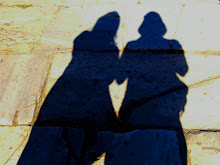 San Sebastian, Spain
San Sebastian, SpainDecember 10, 2007
N43°19.542
W001°59.064
The calm, serene sound from the waves crashing outside our window quickly turned loud and angry, booming and reverberating off of the buildings. The blue waters of the Bay turned frothy and milky white as the waves crashed over the seawall. So large at times they reached the building we’re staying in across the street.
Our room is on the third floor of the building, but it was not spared from the repeated crashes throughout the night. On at least two occasions the waves were so large that they actually reached our balcony, knocking over a chair, a plant, and blasting open the inner door to our bedroom. There were literally gallons of water on the balcony, 3-4 inches deep. On previous nights we slept with our door to the balcony partially open and the storm shutter half way down to let the sweet ocean air into our room. Luckily, maybe it was a premonition; we battened down all the hatches last night.
This morning, after lying awake most of the night due to the merciless sounds of the waves, we opened the wooden door to
 assess the damage. The balcony floor was covered with dirt from the uprooted plant, the chair on its side, and an inch of saltwater slowly drained into the street. The glass railings protecting the balcony were hazy and covered with sea salt. We could hear the sounds of an electric drill and hammer working feverishly. Where, we do not know. The waves, obviously tired from last night’s performance, were bouncing off of the sea wall, as the sun shone down upon them—at least for a brief moment.
assess the damage. The balcony floor was covered with dirt from the uprooted plant, the chair on its side, and an inch of saltwater slowly drained into the street. The glass railings protecting the balcony were hazy and covered with sea salt. We could hear the sounds of an electric drill and hammer working feverishly. Where, we do not know. The waves, obviously tired from last night’s performance, were bouncing off of the sea wall, as the sun shone down upon them—at least for a brief moment.We’ll head out today, our last day in San Sebastian, and continue to explore the city. It will be the first days the stores are open since arriving. Hopefully, as we head out the winds and rains will have died down, and tonight the unforgiving Bay of Biscay will remain calm and allow us to sleep—to enjoy the peaceful, serene sounds of the waves crashing.
---------------------------------------------------------------------

When we finally headed out into the streets this morning, we turned towards the sea and witnessed the destruction from last night’s performance. The railing along the sidewalk promenade was gnarled and tossed aside, a parking meter, uprooted from somewhere, was in the middle of the street still on its concrete base, boulders the size of very large beach balls littered the street. The windows of our building were knocked out on the first and second floors, as was all of the glass to the balconies, the worst damage in the unit just below us.
Each time the wave crashed throughout the night, I could hear the “Whoomp” before it crashed down; however, I had no idea of the damage and destruction the sea was causing only a few feet below us, even tearing the paint off of the exterior wall.
 As we stood on the street, taking pictures and making videos, the sea once again splashed over the sea wall, drenching us. I have a feeling the large crashes will relentlessly continue tonight. Maybe we should stay a little further from the water during our trek up the Atlantic Coast.
As we stood on the street, taking pictures and making videos, the sea once again splashed over the sea wall, drenching us. I have a feeling the large crashes will relentlessly continue tonight. Maybe we should stay a little further from the water during our trek up the Atlantic Coast. 
1 comment:
Your waves are probably part of this thing " It is understood that low pressure near Iceland is causing the high sea levels with waves growing for between 500 and 600 miles by the time they crash against the Irish coastline.
Dr Glenn Nolan, of the Marine Institute, said: "This is allowing waves to travel all the way uninterrupted to the Irish coast.
Post a Comment